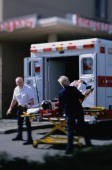
TUESDAY, Jan. 14 (HealthDay News) — When a person’s heart stops beating, most emergency personnel have been taught to first insert a breathing tube through the victim’s mouth, but a new Japanese study found that approach may actually lower the chances of survival and lead to worse neurological outcomes.
Health care professionals have long been taught the A-B-C method, focusing first on the airway and breathing and then circulation, through hand compressions on the chest, explained Dr. Donald Yealy, chair of emergency medicine at the University of Pittsburgh and co-author of an editorial accompanying the study.
But it may be more important to first restore circulation and get the blood moving through the body, he said. “We’re not saying the airway isn’t important, but rather that securing the airway should happen after succeeding in restoring the pulse,” he explained.
The study compared cases of cardiac arrest in which a breathing tube was inserted — considered advanced airway management — to cases using conventional bag-valve-mask ventilation.
There are a number of reasons why the use of a breathing tube in cardiac arrest may reduce effectiveness and even the odds of survival. “Every time you stop chest compressions, you start at zero building a wave of perfusion [getting the blood to circulate]. You’re on a clock, and there are only so many hands in the field,” Yealy said.
Study author Dr. Kohei Hasegawa, a clinical instructor in surgery at Harvard Medical School, gave another reason to prioritize chest compressions over airway restoration.
Because many first responders don’t get the chance to place breathing tubes more than once or twice a year, he said, “it’s difficult to get practice, so the chances you’re doing intubation successfully are very small.”
Hasegawa also noted that it’s especially difficult to insert a breathing tube in the field, such as in someone’s living room or out on the street.
Yealy said that inserting what is called an “endotracheal tube” or a “supraglottic [over-the-tongue] airway” in people who have a cardiac arrest out of the hospital has been standard practice since the 1970s. But recent studies have suggested that it may not be helping people survive and could even be responsible for serious mental disabilities in survivors.
That spurred Japanese researchers to undertake a large-scale study, expanding and testing the research that had previously been done, Hasegawa said. Their findings are published in the Jan. 16 issue of the Journal of the American Medical Association.
The researchers had emergency service personnel working throughout Japan report every case of cardiac arrest and note related data — such as age and sex of each patient, the cause of the cardiac arrest, the technique of airway management used and outcomes — over six years.
Almost 650,000 adult patients with out-of-hospital cardiac arrest were documented. The researchers analyzed the data to see what factors were associated with a favorable neurological outcome, ranging from good mental performance to moderate disability and severe cerebral disability to vegetative state and death. They also wanted to see what methods appeared to be more or less successful in getting the heart to restart before arrival at the hospital, and achieving one-month survival.
The researchers found that using any type of advanced airway management — such as endotracheal intubation or supraglottic airway — was associated with decreased odds of having a favorable neurological outcome. Those patients who were treated with only the less advanced bag-valve-mask ventilation tended to do better.
However, the study did not establish a cause-and-effect relationship between airway management method and survival and neurological outcomes in cardiac arrest.
Both Yealy and Hasegawa agree that despite the size of this study, it is too soon to recommend a change in practice. “This very basic question of how to best resuscitate a person with cardiac arrest, we can’t even answer,” said Yealy.
Emergency medical services staff must use the scientific process to learn more about what works and what doesn’t, Yealy explained. “We can’t tell you the best way yet.”
More information
To learn more about CPR, see the U.S. National Library of Medicine.

